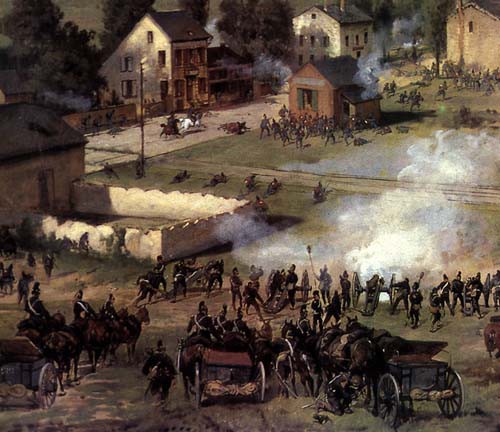The main museum of Sedan is located in the largest castle of Europe with an area of 35,000 m². The battle of Sedan, which took place on 1 September 1870, saw the defeat of the army of Marshall MacMahon, who was beaten and made prisoner by the troups of the royal prince of Saxony. Napoleon III, present on this grievous day, was himself made prisoner and sent to the Wilhemhöhe Castle in Westphalia. A disaster for the French and a prestigious victory for the Germans, Sedan lead to the fall of the Second Empire and the decline of Napoleon III.
The Sedan Museum possesses one room dedicated to the war of 1870 with one important piece: a panoramic study of the Sedan battle by the Bavarian painter Ludwig Braun. An oil on canvas measuring 1.57 by 11.30 meters, this work is one tenth the size of the panorama exhibited from 1880 to 1885 in Frankfurt in a rotunda specifically designed for that purpose.
Braun, who was a fervent admirer of the panorama by Philipoteaux “The Defense of Paris” presented at the World’s Fair of 1878 in Paris, was entrusted with the general conception of the painting and with the painting of the figures. The painter Frosch completed the achitectural section while Biberstein and Lohr were in charge of the landscapes. In this panorama, in which the tones of Ardennes perfectly captured, Braun has condensed the different stages of of this historic day: Bazeilles is in flames, the Marguerite division charges Floing, etc. The general landscape, while incredibly accurate, is inexact with regard to a few small details as with the representation of the private castle-fort of Sedan and its twin towers (our illustration).
The inauguration of the panorama was on 1 September 1880, the anniversary of the battle of Sedan, celebrated with elation by the Germans as the “Sedanstag”. It brought together thousands of visitors, arousing the interest of both the general public and of artistic circles. From all over Germany families came to contemplate the battle in which at least one of their relatives took part. Even the art critics, normally harsh when it came to panoramas, hailed the great quality of the work. The enthusiasm for the panorama of Sedan lasted until 1885, when it was taken down and replaced by “The combat of Weissenburg,” also executed by Braun.
The Sedan Museum has other painted works dedicated to the Napoleonic wars and notably a few pieces by Edouard Detaille and Alphonse de Neuville. Among the sculptures dedicated to the French-German conflict of 1870 are a model of the monument to the dead of Sedan and a plaster by Rodin representing General Marguerite. The museum collection is completed with an exhibit of arms from the era.


